Investigation into the Rationale of Migration Intention Due to Air Pollution Integrating the Homo Oeconomicus Traits
Abstract
:1. Introduction
2. Methodology
2.1. Theoretical Foundation and Model Construction
2.2. Variable Selection
2.3. Analysis and Validation
3. Results
3.1. Model 1: Intention of Immigration to Other Provinces
3.2. Model 2: Emigration Intention to Another Country with Lower Air Pollution Level
4. Discussion
5. Conclusions
Author Contributions
Funding
Data Availability Statement
Conflicts of Interest
Appendix A
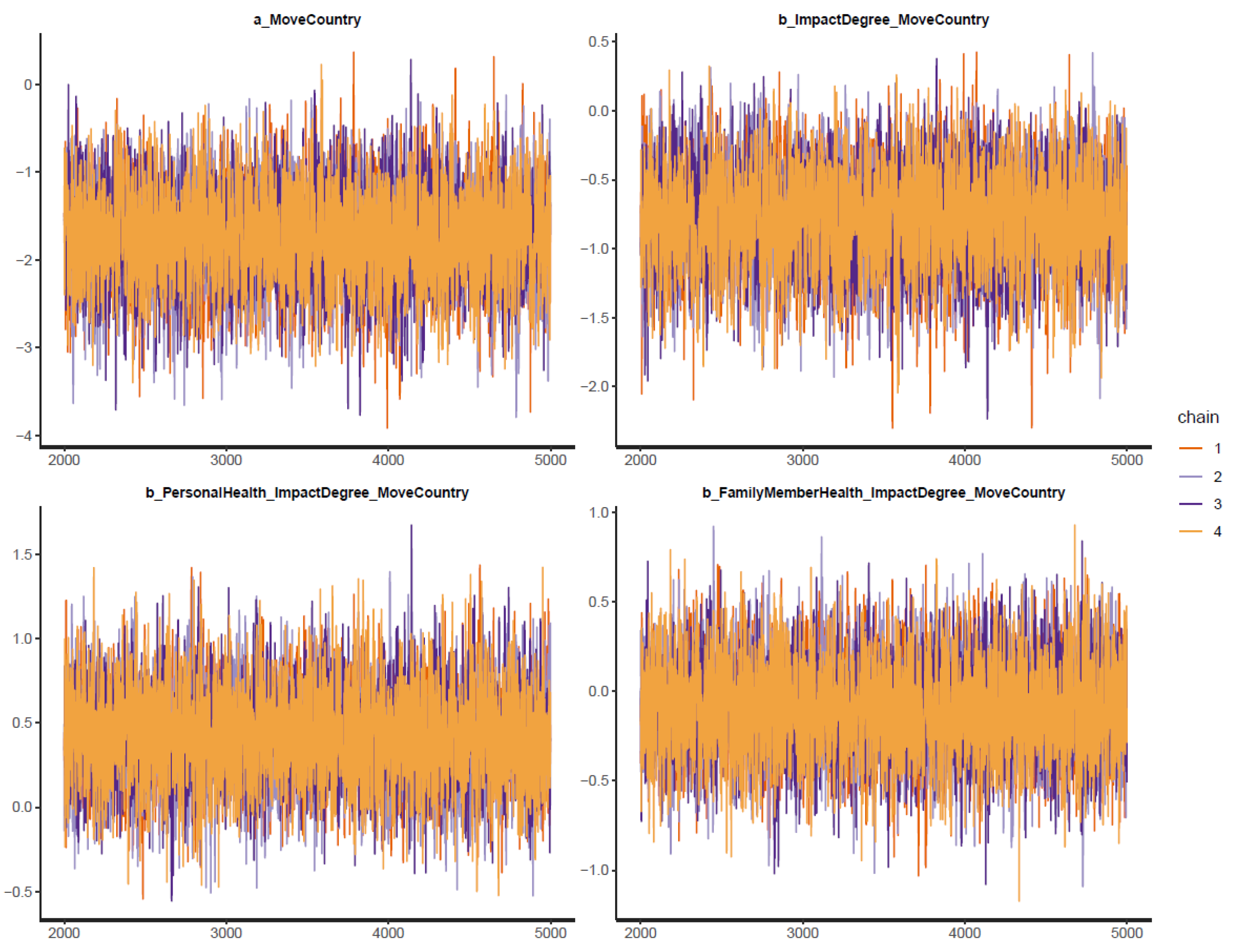
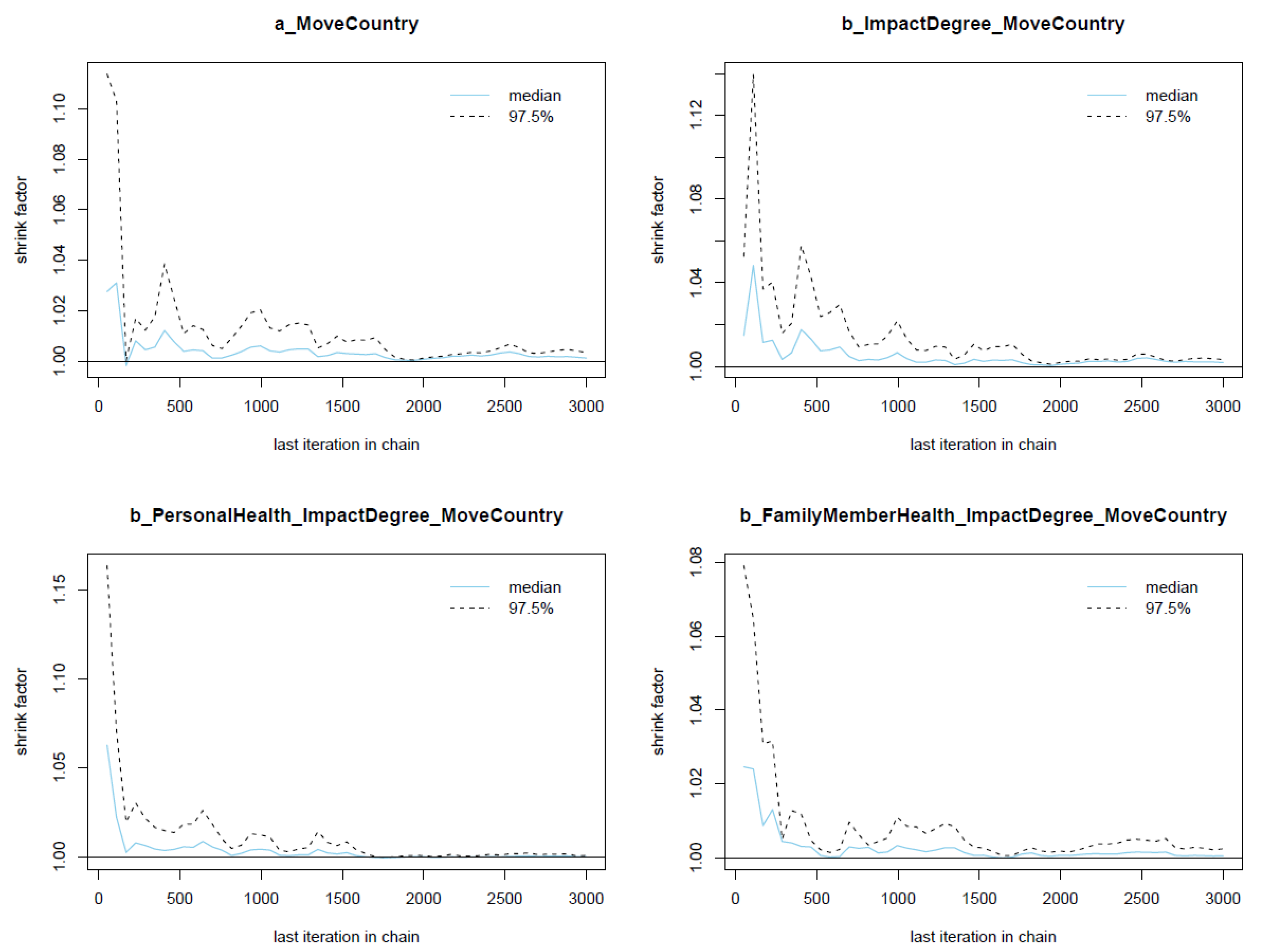
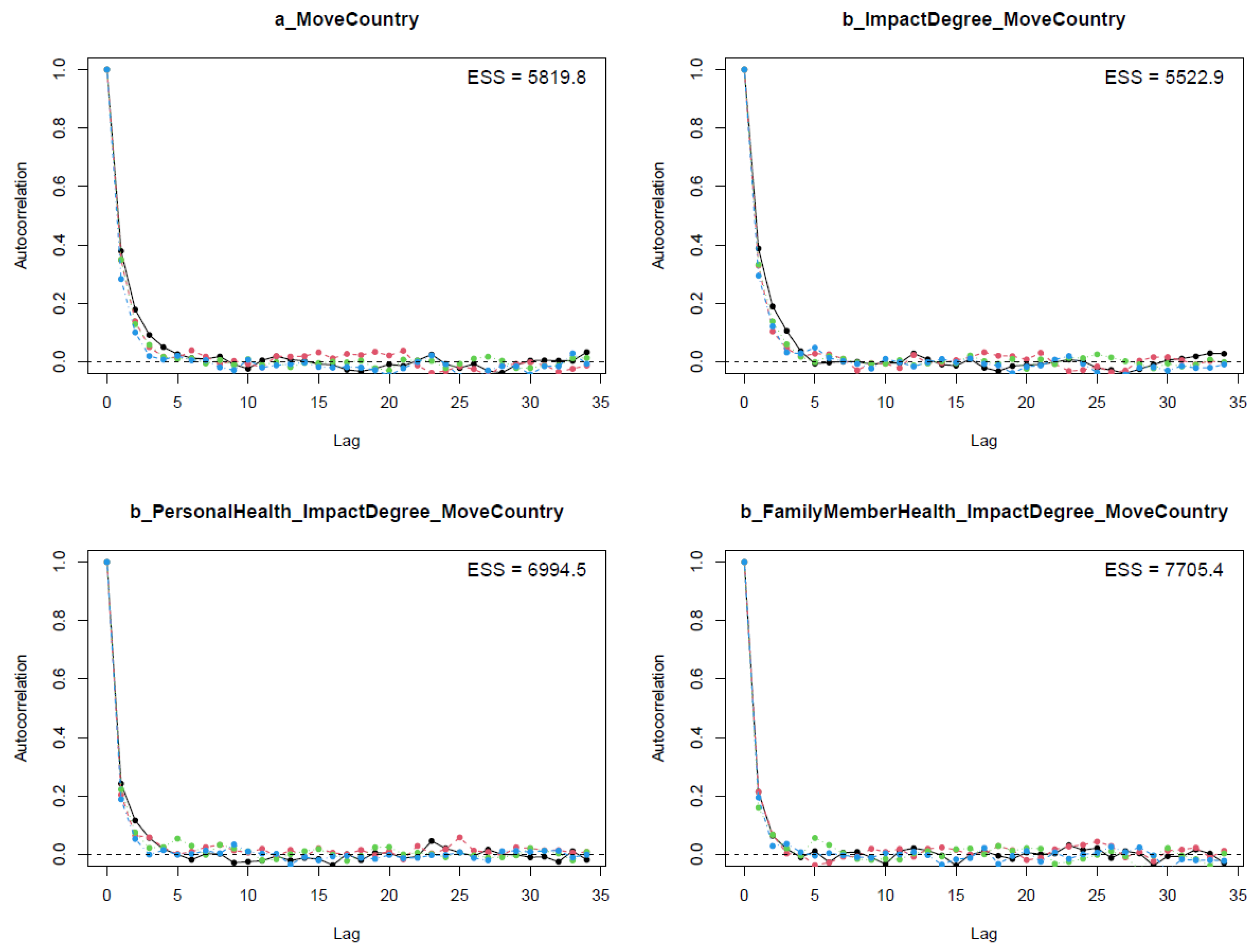
References
- Pandey, G.; Jain, R.K. Bacterial Chemotaxis toward Environmental Pollutants: Role in Bioremediation. Appl. Environ. Microbiol. 2002, 68, 5789–5795. [Google Scholar] [CrossRef]
- Adler, J. Chemotaxis in Bacteria. Annu. Rev. Biochem. 1975, 44, 341–356. [Google Scholar] [CrossRef] [PubMed]
- Klein, S.; Cabirol, A.; Devaud, J.-M.; Barron, A.B.; Lihoreau, M. Why Bees Are So Vulnerable to Environmental Stressors. Trends Ecol. Evol. 2017, 32, 268–278. [Google Scholar] [CrossRef] [PubMed]
- Skov, C.; Aarestrup, K.; Baktoft, H.; Brodersen, J.; Brönmark, C.; Hansson, L.-A.; Nielsen, E.E.; Nielsen, T.; Nilsson, P.A. Influences of environmental cues, migration history, and habitat familiarity on partial migration. Behav. Ecol. 2010, 21, 1140–1146. [Google Scholar] [CrossRef]
- National Wildlife Federation. Habitat Loss. Available online: https://www.nwf.org/Home/Educational-Resources/Wildlife-Guide/Threats-to-Wildlife/Habitat-Loss (accessed on 30 November 2021).
- March, J.G. Learning to be risk averse. Psychol. Rev. 1996, 103, 309–319. [Google Scholar] [CrossRef]
- Ajzen, I. From Intentions to Actions: A Theory of Planned Behavior. In Action Control; Kuhl, J., Beckmann, J., Eds.; Springer: Berlin/Heidelberg, Germany, 1985; pp. 11–39. [Google Scholar]
- Bresnahan, B.W.; Dickie, M.; Gerking, S. Averting Behavior and Urban Air Pollution. Land Econ. 1997, 73, 340. [Google Scholar] [CrossRef]
- Zivin, J.G.; Neidell, M. Days of haze: Environmental information disclosure and intertemporal avoidance behavior. J. Environ. Econ. Manag. 2009, 58, 119–128. [Google Scholar] [CrossRef]
- Currie, J.; Hanushek, E.A.; Kahn, E.M.; Neidell, M.; Rivkin, S.G. Does Pollution Increase School Absences? Rev. Econ. Stat. 2009, 91, 682–694. [Google Scholar] [CrossRef]
- Saberian, S.; Heyes, A.; Rivers, N. Alerts work! Air quality warnings and cycling. Resour. Energy Econ. 2017, 49, 165–185. [Google Scholar] [CrossRef]
- Noonan, D.S. Smoggy with a Chance of Altruism: The Effects of Ozone Alerts on Outdoor Recreation and Driving in Atlanta. Policy Stud. J. 2014, 42, 122–145. [Google Scholar] [CrossRef]
- Wolpert, J. Migration as an Adjustment to Environmental Stress. J. Soc. Issues 1966, 22, 92–102. [Google Scholar] [CrossRef]
- Kim, B. Do Air Quality Alerts Affect Household Migration? South. Econ. J. 2019, 85, 766–795. [Google Scholar] [CrossRef]
- Liu, Z.; Yu, L. Stay or Leave? The Role of Air Pollution in Urban Migration Choices. Ecol. Econ. 2020, 177, 106780. [Google Scholar] [CrossRef]
- Gholipour, H.F.; Farzanegan, M.R.; Javadian, M. Air Pollution and Internal Migration: Evidence from Iranian Household Survey; ID 3541456; Social Science Research Network: Rochester, NY, USA, 2020. [Google Scholar]
- Germani, A.R.; Scaramozzino, P.; Castaldo, A.; Talamo, G. Does air pollution influence internal migration? An empirical investigation on Italian provinces. Environ. Sci. Policy 2021, 120, 11–20. [Google Scholar] [CrossRef]
- Chen, S.; Oliva, P.; Zhang, P. The effect of air pollution on migration: Evidence from China. J. Dev. Econ. 2022, 156, 102833. [Google Scholar] [CrossRef]
- Vuong, Q.-H.; Le, T.-T.; Khuc, Q.V.; Nguyen, Q.-L.; Nguyen, M.-H. Escaping from air pollution: Exploring the psychological mechanism behind the emergence of internal migration intention among urban residents. Int. J. Environ. Res. Public Health 2022, 19, 12233. [Google Scholar] [CrossRef]
- Hugo, G. Environmental Concerns and International Migration. Int. Migr. Rev. 1996, 30, 105–131. [Google Scholar] [CrossRef] [PubMed]
- Qin, Y.; Zhu, H. Run away? Air pollution and emigration interests in China. J. Popul. Econ. 2018, 31, 235–266. [Google Scholar] [CrossRef]
- Ravenstein, E.G. The Laws of Migration. J. R. Stat. Soc. 1889, 52, 241–305. [Google Scholar] [CrossRef]
- Stouffer, S.A. Intervening Opportunities: A Theory Relating Mobility and Distance. Am. Sociol. Rev. 1940, 5, 845–867. [Google Scholar] [CrossRef]
- Lee, E.S. A theory of migration. Demography 1966, 3, 47–57. [Google Scholar] [CrossRef]
- Claeson, A.-S.; Lidén, E.; Nordin, M.; Nordin, S. The role of perceived pollution and health risk perception in annoyance and health symptoms: A population-based study of odorous air pollution. Int. Arch. Occup. Environ. Health 2013, 86, 367–374. [Google Scholar] [CrossRef] [PubMed]
- Kampa, M.; Castanas, E. Human health effects of air pollution. Environ. Pollut. 2008, 151, 362–367. [Google Scholar] [CrossRef] [PubMed]
- Sass, V.; Kravitz-Wirtz, N.; Karceski, S.M.; Hajat, A.; Crowder, K.; Takeuchi, D. The effects of air pollution on individual psychological distress. Health Place 2017, 48, 72–79. [Google Scholar] [CrossRef] [PubMed]
- Vert, C.; Sánchez-Benavides, G.; Martínez, D.; Gotsens, X.; Gramunt, N.; Cirach, M.; Molinuevo, J.L.; Sunyer, J.; Nieuwenhuijsen, M.J.; Crous-Bou, M.; et al. Effect of long-term exposure to air pollution on anxiety and depression in adults: A cross-sectional study. Int. J. Hyg. Environ. Health 2017, 220, 1074–1080. [Google Scholar] [CrossRef]
- Li, T.; Liu, H.; Salvo, A. Severe Air Pollution and Labor Productivity: Evidence from Industrial Towns in China. Am. Econ. J. Appl. Econ. 2019, 11, 173–201. [Google Scholar] [CrossRef]
- Chang, T.Y.; Graff Zivin, J.; Gross, T.; Neidell, M. The effect of pollution on worker productivity: Evidence from call center workers in China. Am. Econ. J. Appl. Econ. 2019, 11, 151–172. [Google Scholar] [CrossRef]
- Kim, K.-N.; Lim, Y.-H.; Bae, H.J.; Kim, M.; Jung, K.; Hong, Y.-C. Long-Term Fine Particulate Matter Exposure and Major Depressive Disorder in a Community-Based Urban Cohort. Environ. Health Perspect. 2016, 124, 1547–1553. [Google Scholar] [CrossRef]
- Casas, L.; Cox, B.; Bauwelinck, M.; Nemery, B.; Deboosere, P.; Nawrot, T.S. Does air pollution trigger suicide? A case-crossover analysis of suicide deaths over the life span. Eur. J. Epidemiol. 2017, 32, 973–981. [Google Scholar] [CrossRef]
- Kim, Y.; Ng, C.F.S.; Chung, Y.; Kim, H.; Honda, Y.; Guo, Y.L.; Lim, Y.-H.; Chen, B.-Y.; Page, L.A.; Hashizume, M. Air Pollution and Suicide in 10 Cities in Northeast Asia: A Time-Stratified Case-Crossover Analysis. Environ. Health Perspect. 2018, 126, 037002. [Google Scholar] [CrossRef]
- Szyszkowicz, M.; Willey, J.B.; Grafstein, E.; Rowe, B.H.; Colman, I. Air Pollution and Emergency Department Visits for Suicide Attempts in Vancouver, Canada. Environ. Health Insights 2010, 4, 79–86. [Google Scholar] [CrossRef] [PubMed]
- Chen, J.-C.; Schwartz, J. Neurobehavioral effects of ambient air pollution on cognitive performance in US adults. Neurotoxicology 2009, 30, 231–239. [Google Scholar] [CrossRef] [PubMed]
- Zhang, X.; Chen, X.; Zhang, X. The impact of exposure to air pollution on cognitive performance. Proc. Natl. Acad. Sci. USA 2018, 115, 9193–9197. [Google Scholar] [CrossRef] [PubMed]
- Ranft, U.; Schikowski, T.; Sugiri, D.; Krutmann, J.; Krämer, U. Long-term exposure to traffic-related particulate matter impairs cognitive function in the elderly. Environ. Res. 2009, 109, 1004–1011. [Google Scholar] [CrossRef] [PubMed]
- Oudin, A.; Forsberg, B.; Adolfsson, A.N.; Lind, N.; Modig, L.; Nordin, M.; Nordin, S.; Adolfsson, R.; Nilsson, L.-G. Traffic-Related Air Pollution and Dementia Incidence in Northern Sweden: A Longitudinal Study. Environ. Health Perspect. 2016, 124, 306–312. [Google Scholar] [CrossRef] [PubMed]
- Pozzer, A.; Dominici, F.; Haines, A.; Witt, C.; Münzel, T.; Lelieveld, J. Regional and global contributions of air pollution to risk of death from COVID-19. Cardiovasc. Res. 2020, 116, 2247–2253. [Google Scholar] [CrossRef]
- Hunter, L.M. Migration and Environmental Hazards. Popul. Environ. 2005, 26, 273–302. [Google Scholar] [CrossRef]
- Persky, J. The Ethology of Homo Economicus. J. Econ. Perspect. 1995, 9, 221–231. [Google Scholar] [CrossRef]
- Fleming, P. The Death of Homo Economicus: Work, Debt and the Myth of Endless Accumulation; Pluto Press: London, UK, 2017; p. 314. [Google Scholar]
- Levitt, S.D.; List, J.A. Homo economicus Evolves. Science 2008, 319, 909–910. [Google Scholar] [CrossRef]
- Henrich, J.; Boyd, R.; Bowles, S.; Camerer, C.; Fehr, E.; Gintis, H.; McElreath, R. In Search of Homo Economicus: Behavioral Experiments in 15 Small-Scale Societies. Am. Econ. Rev. 2001, 91, 73–78. [Google Scholar] [CrossRef]
- Rankin, M.A.; Burchsted, J.C.A. The Cost of Migration in Insects. Annu. Rev. Entomol. 1992, 37, 533–559. [Google Scholar] [CrossRef]
- Schwartz, A. Interpreting the Effect of Distance on Migration. J. Political Econ. 1973, 81, 1153–1169. [Google Scholar] [CrossRef]
- Ward, C.; Bochner, S.; Furnham, A. The Psychology of Culture Shock, 2nd ed.; Routledge: Oxfordshire, UK, 2020. [Google Scholar]
- Wolf, M.J.; Emerson, J.W.; Esty, D.C.; Sherbinin, A.d.; Wendling, Z.A. 2022 Environmental Performance Index; Yale Center for Environmental Law & Policy: New Haven, CT, USA, 2022. [Google Scholar]
- Iqair. World Air Quality Report 2019—Region and City PM2.5 Ranking; IQAir: Delhi, India, 2019. [Google Scholar]
- Hien, P.; Men, N.; Tan, P.; Hangartner, M. Impact of urban expansion on the air pollution landscape: A case study of Hanoi, Vietnam. Sci. Total Environ. 2020, 702, 134635. [Google Scholar] [CrossRef] [PubMed]
- Phung, D.; Hien, T.T.; Linh, H.N.; Luong, L.M.; Morawska, L.; Chu, C.; Binh, N.D.; Thai, P.K. Air pollution and risk of respiratory and cardiovascular hospitalizations in the most populous city in Vietnam. Sci. Total Environ. 2016, 557, 322–330. [Google Scholar] [CrossRef]
- Vu Van, H.; Le Xuan, Q.; Pham Ngoc, H.; Luc, H. Health risk assessment of mobility-related air pollution in Ha Noi, Vietnam. J. Environ. Prot. 2013, 4, 38678. [Google Scholar] [CrossRef]
- Khuc, Q.V.; Nguyen, M.-H.; Le, T.-T.; Nguyen, T.-L.; Nguyen, T.; Lich, H.K.; Vuong, Q.-H. Brain drain out of the blue: Pollution-induced migration in Vietnam. Int. J. Environ. Res. Public Health 2022, 19, 3645. [Google Scholar] [CrossRef]
- Vuong, Q.-H.; Napier, N.K. Acculturation and global mindsponge: An emerging market perspective. Int. J. Intercult. Relat. 2015, 49, 354–367. [Google Scholar] [CrossRef]
- Vuong, Q.-H. Mindsponge Theory; De Gruyter: Berlin, Germany, 2023. [Google Scholar]
- Vuong, Q.-H.; Le, T.-T.; La, V.-P.; Nguyen, H.T.T.; Ho, M.-T.; Van Khuc, Q.; Nguyen, M.-H. COVID-19 vaccines production and societal immunization under the serendipity-mindsponge-3D knowledge management theory and conceptual framework. Humanit. Soc. Sci. Commun. 2022, 9, 22. [Google Scholar] [CrossRef]
- Vuong, Q.-H. A New Theory of Serendipity: Nature, Emergence and Mechanism; De Gruyter: Berlin, Germany, 2022. [Google Scholar]
- Maslow, A.H. Motivation and Personality; Prabhat Prakashan: New Delhi, India, 1981. [Google Scholar]
- Hofstede, G. Culture’s Consequences: International Differences in Work-Related Values; Sage: Newbury Park, CA, USA, 1984; Volume 5. [Google Scholar]
- Nonaka, I.; Konno, N. The concept of “Ba”: Building a foundation for knowledge creation. Calif. Manag. Rev. 1998, 40, 40–54. [Google Scholar] [CrossRef]
- Mintzberg, H. Nature of Managerial Work; Harper & Row: New York, NY, USA, 1973. [Google Scholar]
- Porter, M.E. Competitive strategy. Meas. Bus. Excell. 1997, 1, 12–17. [Google Scholar] [CrossRef]
- Vuong, Q.-H.; Le, T.-T.; Jin, R.; Khuc, Q.V.; Nguyen, H.-S.; Vuong, T.-T.; Nguyen, M.-H. Near-suicide phenomenon: An investigation into the psychology of patients with serious illnesses withdrawing from treatment. Int. J. Environ. Res. Public Health 2023, 20, 5173. [Google Scholar] [CrossRef] [PubMed]
- Nguyen, M.-H.; Jones, T.E. Building eco-surplus culture among urban residents as a novel strategy to improve finance for conservation in protected areas. Humanit. Soc. Sci. Commun. 2022, 9, 426. [Google Scholar] [CrossRef] [PubMed]
- Nguyen, M.-H.; Jones, T.E. Predictors of support for biodiversity loss countermeasures and bushmeat consumption among Vietnamese urban residents. Conserv. Sci. Pract. 2022, 4, e12822. [Google Scholar] [CrossRef]
- Vuong, Q.-H.; Le, T.-T.; La, V.-P.; Nguyen, M.-H. The psychological mechanism of Internet information processing for post-treatment evaluation. Heliyon 2022, 8, E09351. [Google Scholar] [CrossRef] [PubMed]
- Vuong, Q.-H.; Nguyen, M.-H.; Le, T.-T. A Mindsponge-Based Investigation into the Psycho-Religious Mechanism behind Suicide Attacks; De Gruyter: Berlin, Germany, 2021. [Google Scholar]
- Nguyen, M.-H.; Le, T.-T.; Vuong, Q.-H. Ecomindsponge: A novel perspective on human psychology and behavior in the ecosystem. Urban Sci. 2023, 7, 31. [Google Scholar] [CrossRef]
- Vuong, Q.-H. Meandering Sobriety; AISDL: Hanoi, Vietnam, 2023. [Google Scholar]
- Khuc, Q.V.; Tran, M.; Nguyen, T.; Thinh, N.A.; Dang, T.; Tuyen, D.T.; Pham, P.; Dat, L.Q. Improving energy literacy to facilitate energy transition and nurture environmental culture in Vietnam. Urban Sci. 2023, 7, 13. [Google Scholar] [CrossRef]
- Khuc, Q.V.; Nguyen, T.; Nguyen, T.; Pham, L.; Le, D.-T.; Ho, H.-H.; Truong, T.-B.; Tran, Q.-K. Young adults’ intentions and rationales for COVID-19 vaccination participation: Evidence from a student survey in Ho Chi Minh city, Vietnam. Vaccines 2021, 9, 794. [Google Scholar] [CrossRef]
- Khuc, Q.V.; Dang, T.; Tran, M.; Nguyen, D.T.; Nguyen, T.; Pham, P.; Tran, T. Household-level strategies to tackle plastic waste pollution in a transitional country. Urban Sci. 2023, 7, 20. [Google Scholar] [CrossRef]
- Kruschke, J. Doing Bayesian Data Analysis: A Tutorial with R, JAGS, and Stan; Academic Press: Cambridge, MA, USA, 2014. [Google Scholar]
- Khuc, V.Q.; Phu, T.V.; Luu, P. Dataset on the Hanoian suburbanites’ perception and mitigation strategies towards air pollution. Data Brief 2020, 33, 106414. [Google Scholar] [CrossRef]
- Vuong, Q.-H.; Phu, T.V.; Le, T.-A.T.; Van Khuc, Q. Exploring Inner-City Residents’ and Foreigners’ Commitment to Improving Air Pollution: Evidence from a Field Survey in Hanoi, Vietnam. Data 2021, 6, 39. [Google Scholar] [CrossRef]
- Nguyen, M.-H.; La, V.-P.; Le, T.-T.; Vuong, Q.-H. Introduction to Bayesian Mindsponge Framework analytics: An innovative method for social and psychological research. MethodsX 2022, 9, 101808. [Google Scholar] [CrossRef] [PubMed]
- Vuong, Q.-H.; Nguyen, M.-H.; La, V.-P. The Mindsponge and BMF Analytics for Innovative Thinking in Social Sciences and Humanities; De Gruyter: Berlin, Germany, 2022. [Google Scholar]
- Kerkhoff, D.; Nussbeck, F.W. The Influence of Sample Size on Parameter Estimates in Three-Level Random-Effects Models. Front. Psychol. 2019, 10, 1067. [Google Scholar] [CrossRef] [PubMed]
- Baker, M. Over half of psychology studies fail reproducibility test. Nat. News 2015, 27, 1–3. [Google Scholar] [CrossRef]
- Open Science Collaboration. Estimating the reproducibility of psychological science. Science 2015, 349, aac4716. [Google Scholar] [CrossRef] [PubMed]
- Halsey, L.G.; Curran-Everett, D.; Vowler, S.L.; Drummond, G.B. The fickle P value generates irreproducible results. Nat. Methods 2015, 12, 179–185. [Google Scholar] [CrossRef]
- Vehtari, A.; Gelman, A.; Gabry, J. Practical Bayesian model evaluation using leave-one-out cross-validation and WAIC. Stat. Comput. 2017, 27, 1413–1432. [Google Scholar] [CrossRef]
- Vuong, Q.-H.; Nguyen, M.-H.; La, V.-P. Updated Protocol for Performing BMF Analytics Using Bayesvl. In The Mindsponge and BMF Analytics for Innovative Thinking in Social Sciences and Humanities; Vuong, Q.-H., Nguyen, M.-H., La, V.-P., Eds.; De Gruyter: Berlin, Germany, 2022; pp. 301–370. [Google Scholar]
- La, V.-P.; Vuong, Q.-H. bayesvl: Visually Learning the Graphical Structure of Bayesian Networks and Performing MCMC with ‘Stan’. In The Comprehensive R Archive Network (CRAN). 2019. Available online: https://philarchive.org/archive/LABVLT (accessed on 30 November 2021).
- Lu, H.; Yue, A.; Chen, H.; Long, R. Could smog pollution lead to the migration of local skilled workers? Evidence from the Jing-Jin-Ji region in China. Resour. Conserv. Recycl. 2018, 130, 177–187. [Google Scholar] [CrossRef]
- Xue, S.; Zhang, B.; Zhao, X. Brain Drain: The Impact of Air Pollution on Firm Performance. SSRN Electron. J. 2019, 110, 102546. [Google Scholar] [CrossRef]
- Chen, S.; Chen, Y.; Lei, Z.; Tan-Soo, J.-S. Chasing clean air: Pollution-induced travels in China. J. Assoc. Environ. Resour. Econ. 2021, 8, 59–89. [Google Scholar] [CrossRef]
- Cebula, R.J.; Vedder, R.K. A Note on Migration, Economic Opportunity, and the Quality of Life. J. Reg. Sci. 1973, 13, 205–211. [Google Scholar] [CrossRef]
- Clemens, M.A. Does Development Reduce Migration? In International Handbook on Migration and Economic Development, Lucas, R.E.B., Ed.; Edward Elgar Publishing: Cheltenham, UK, 2014. [Google Scholar]
- Wendling, Z.A.; Emerson, J.W.; de Sherbinin, A.; Esty, D.C.; Hoving, K.; Ospina, C.D.; Murray, J.M.; Gunn, L.; Ferrato, M.; Schreck, M. 2020 Environmental Performance Index; Yale Center for Environmental Law & Policy: New Haven, CT, USA, 2020. [Google Scholar]
- Lai, W.; Song, H.; Wang, C.; Wang, H. Air pollution and brain drain: Evidence from college graduates in China. China Econ. Rev. 2021, 68, 101624. [Google Scholar] [CrossRef]
- Schon, J. Motivation and opportunity for conflict-induced migration: An analysis of Syrian migration timing. J. Peace Res. 2019, 56, 12–27. [Google Scholar] [CrossRef]
- Feng, S.; Krueger, A.B.; Oppenheimer, M. Linkages among climate change, crop yields and Mexico–US cross-border migration. Proc. Natl. Acad. Sci. USA 2010, 107, 14257–14262. [Google Scholar] [CrossRef] [PubMed]
- Vuong, Q.H. The semiconducting principle of monetary and environmental values exchange. Econ. Bus. Lett. 2021, 10, 284–290. [Google Scholar] [CrossRef]
- Lasko, K.; Vadrevu, K.P.; Nguyen, T.T.N. Analysis of air pollution over Hanoi, Vietnam using multi-satellite and MERRA reanalysis datasets. PLoS ONE 2018, 13, e0196629. [Google Scholar] [CrossRef] [PubMed]
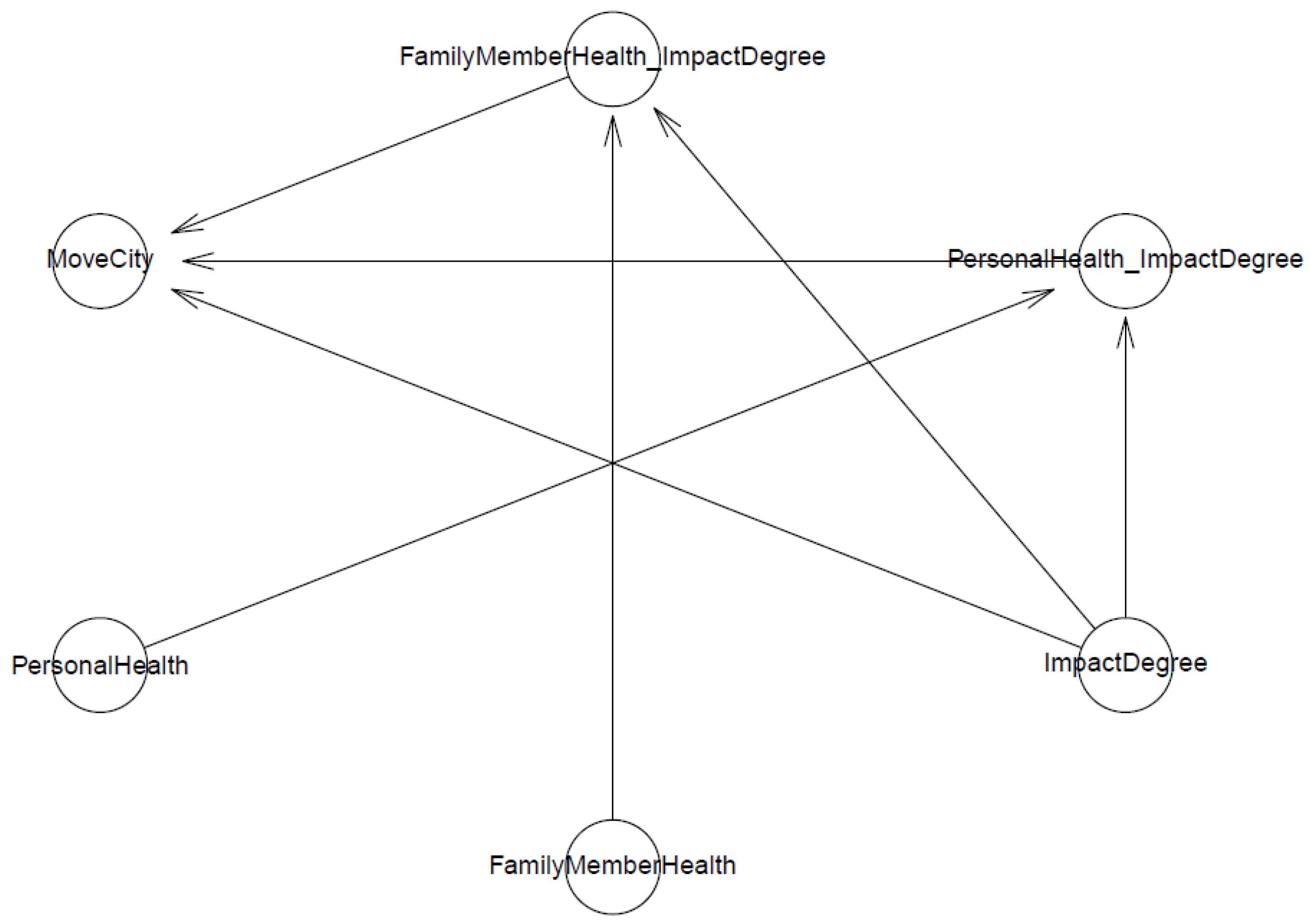
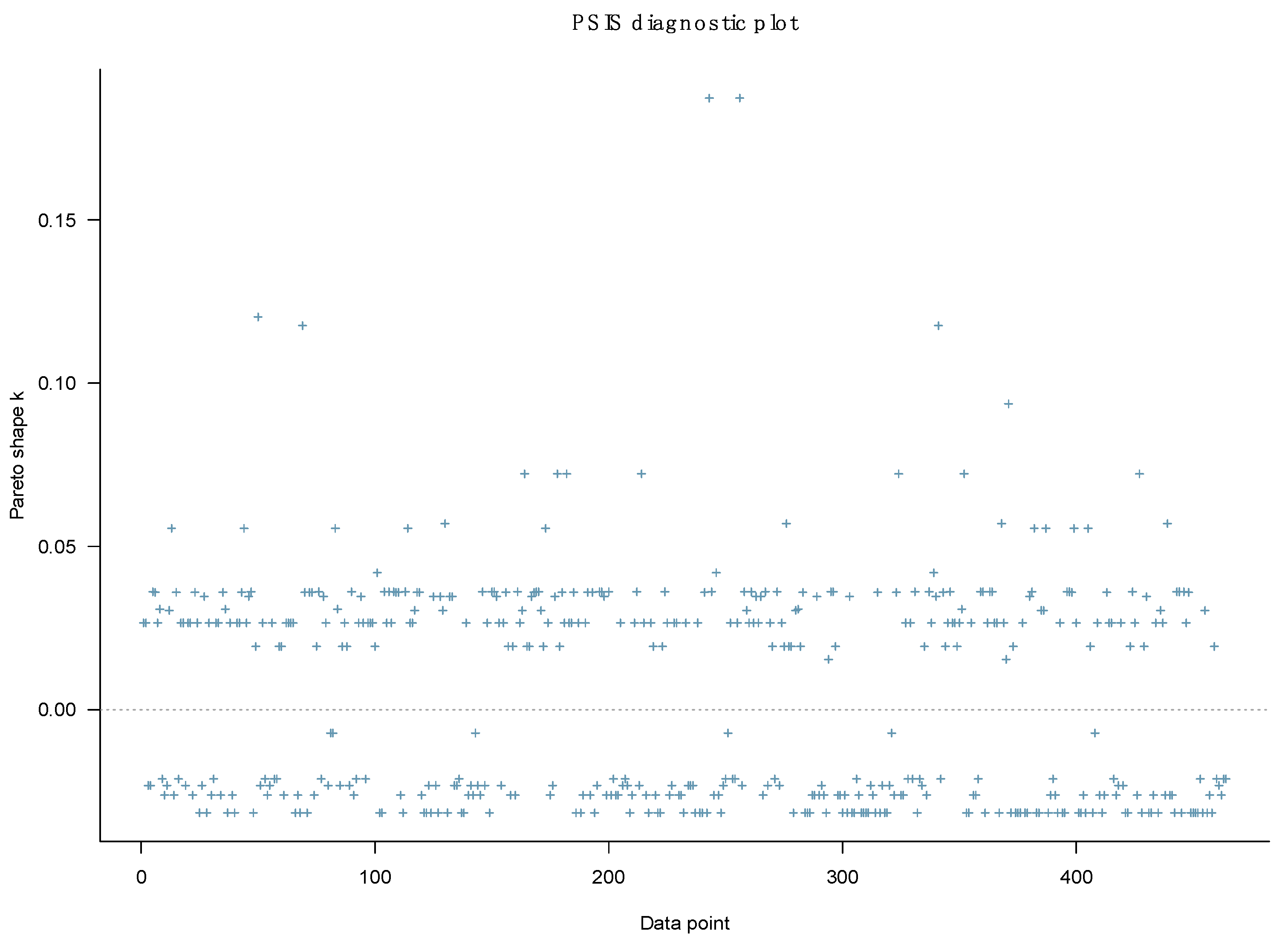
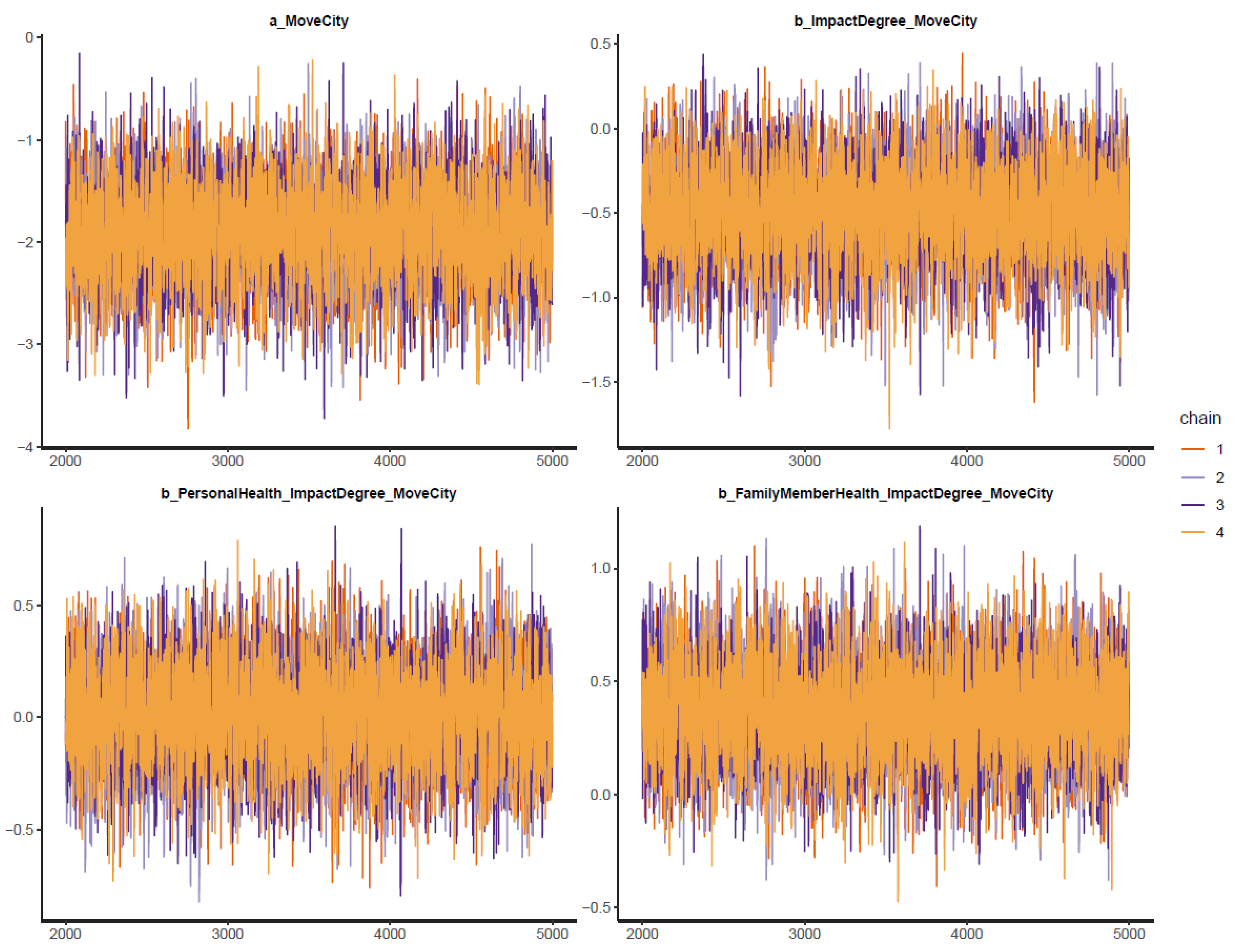
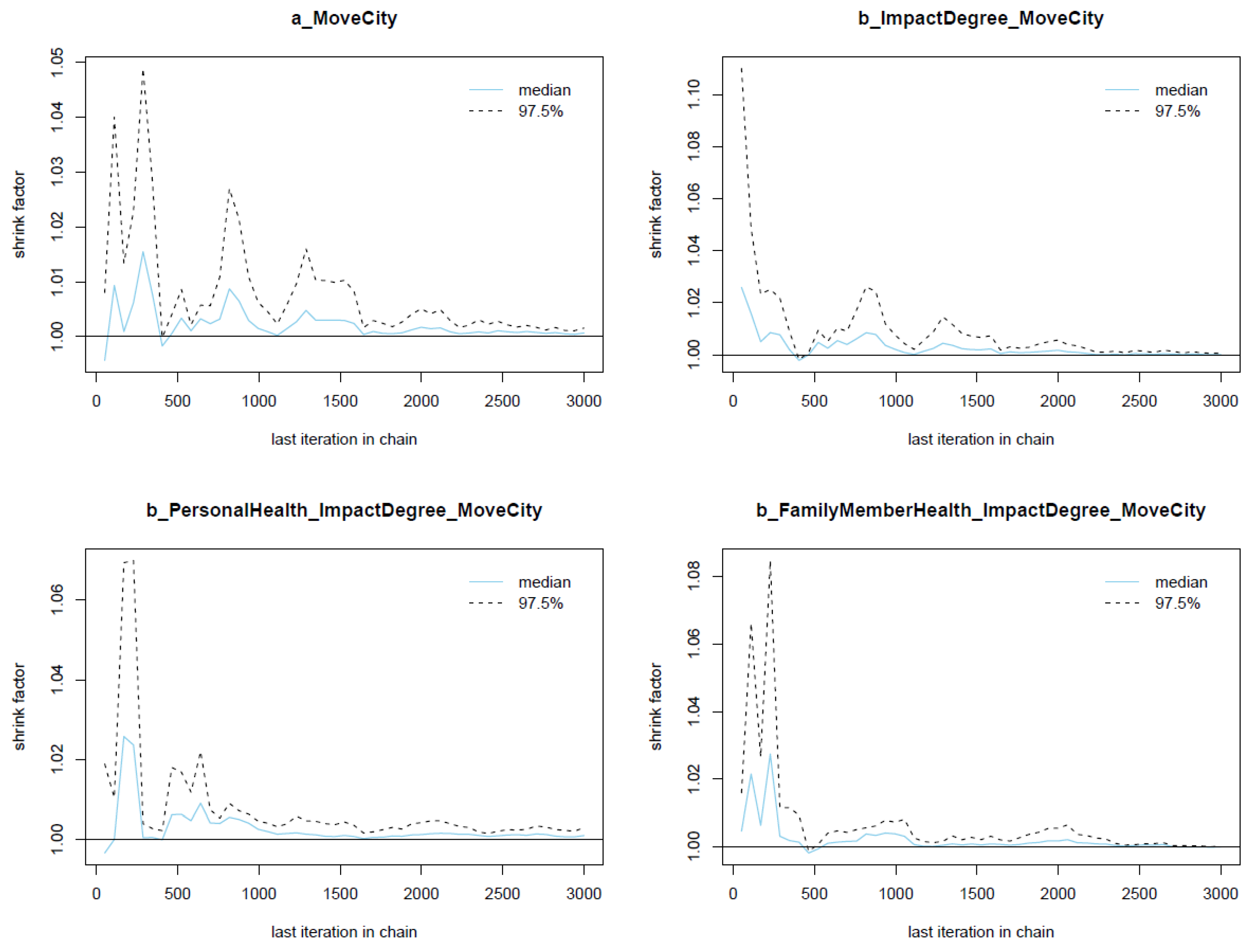

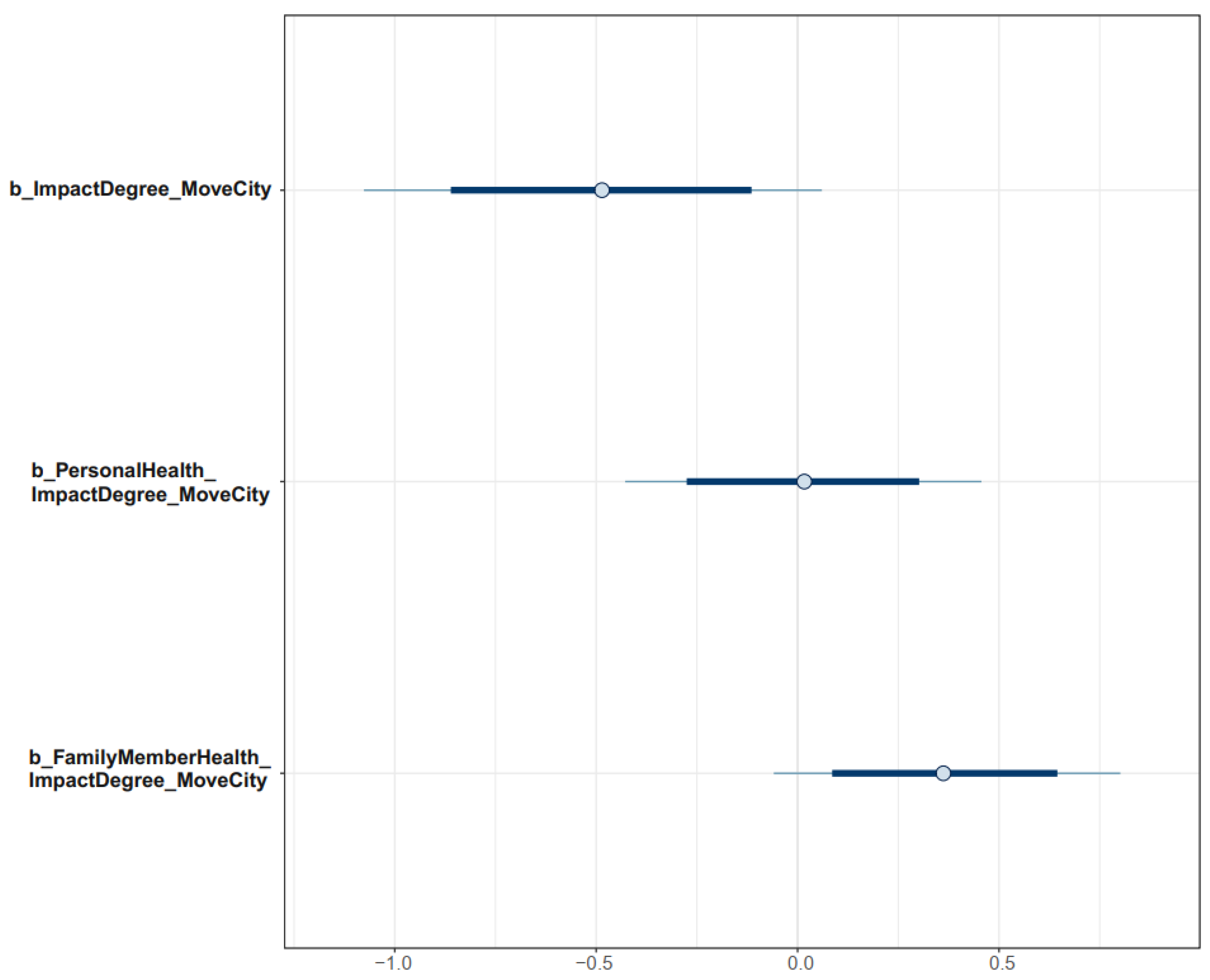

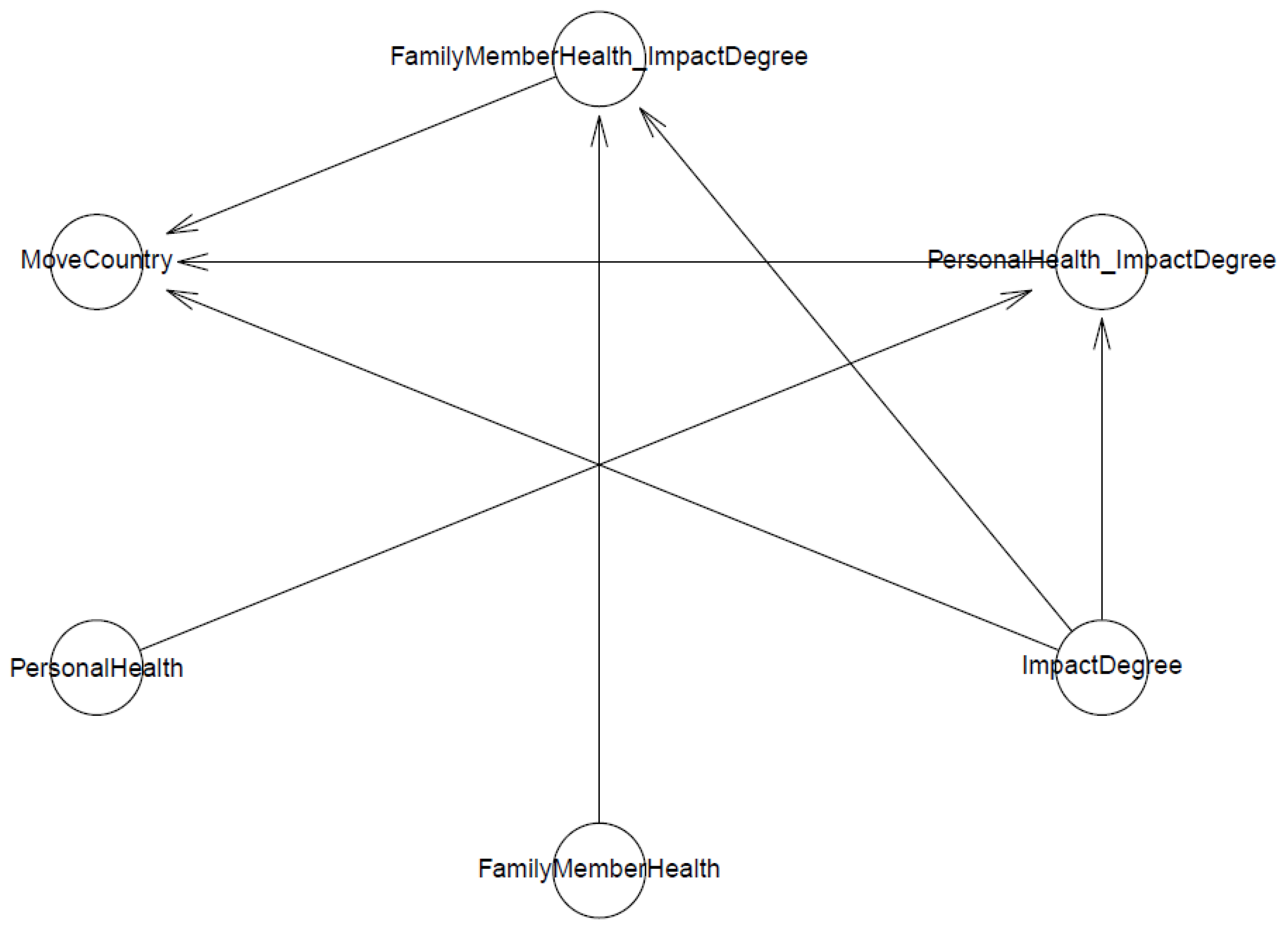

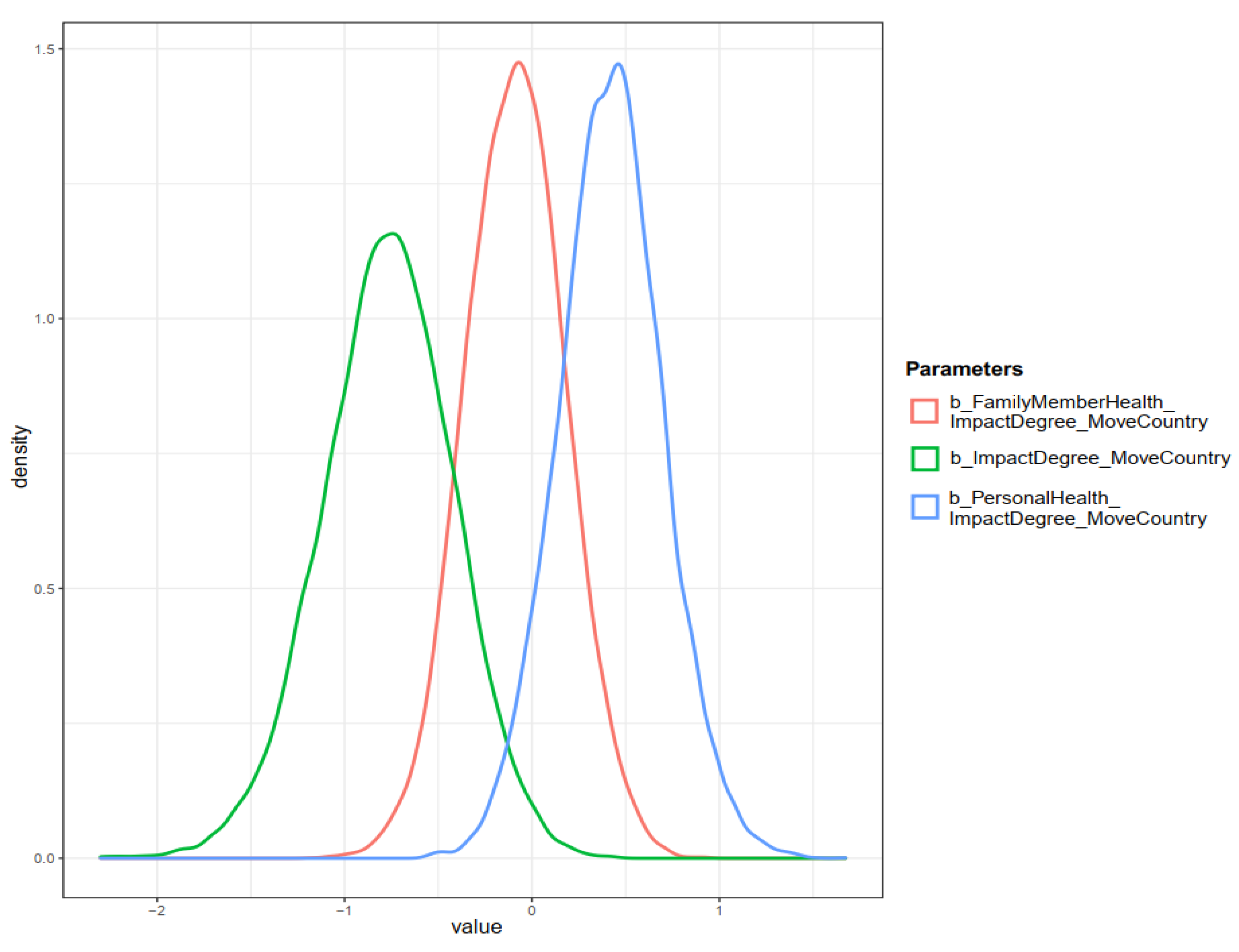

| Variable | Meaning | Type of Variable | Value |
|---|---|---|---|
| MoveCity | Whether the respondent had the intention to move their family and work to a less polluted province due to air pollution concerns | Binary | No = 0 Yes = 1 |
| MoveCountry | Whether the respondent had the intention to move their family and work to a less polluted foreign country due to air pollution concerns | Binary | No = 0 Yes = 1 |
| PersonalHealth | Whether the respondent was sick because of air pollution | Binary | No = 0 Yes = 1 |
| FamilyMemberHealth | Whether any member of the respondent’s family was sick because of air pollution | Binary | No = 0 Do not know = 0 Yes = 1 |
| ImpactDegree | The respondent’s perceived impacts of air pollution on their life | Ordinal | From 1 (very impacted) to 4 (not impacted) |
| Parameters | Uninformative | Belief | Disbelief | n_eff | Rhat | |||
|---|---|---|---|---|---|---|---|---|
| Mean | SD | Mean | SD | Mean | SD | |||
| Constant | −1.90 | 0.49 | −2.00 | 0.48 | −1.89 | 0.48 | 4921 | 1 |
| ImpactDegree | −0.48 | 0.29 | −0.52 | 0.30 | −0.46 | 0.29 | 4933 | 1 |
| PersonalHealth ∗ ImpactDegree | 0.02 | 0.23 | 0.15 | 0.20 | 0.03 | 0.20 | 7545 | 1 |
| FamilyMemberHealth ∗ ImpactDegree | 0.35 | 0.26 | 0.41 | 0.20 | 0.30 | 0.20 | 7541 | 1 |
| Parameters | Uninformative | Belief | Disbelief | n_eff | Rhat | |||
|---|---|---|---|---|---|---|---|---|
| Mean | SD | Mean | SD | Mean | SD | |||
| Constant | −1.74 | 0.55 | −1.82 | 0.55 | −1.69 | 0.54 | 5261 | 1 |
| ImpactDegree | −0.78 | 0.36 | −0.86 | 0.37 | −0.76 | 0.34 | 5513 | 1 |
| PersonalHealth ∗ ImpactDegree | 0.42 | 0.28 | 0.48 | 0.24 | 0.31 | 0.24 | 7542 | 1 |
| FamilyMemberHealth ∗ ImpactDegree | −0.09 | 0.27 | 0.11 | 0.24 | −0.04 | 0.23 | 8015 | 1 |
Disclaimer/Publisher’s Note: The statements, opinions and data contained in all publications are solely those of the individual author(s) and contributor(s) and not of MDPI and/or the editor(s). MDPI and/or the editor(s) disclaim responsibility for any injury to people or property resulting from any ideas, methods, instructions or products referred to in the content. |
© 2023 by the authors. Licensee MDPI, Basel, Switzerland. This article is an open access article distributed under the terms and conditions of the Creative Commons Attribution (CC BY) license (https://creativecommons.org/licenses/by/4.0/).
Share and Cite
Vuong, Q.-H.; Le, T.-T.; La, V.-P.; Vuong, T.-T.; Nguyen, M.-H. Investigation into the Rationale of Migration Intention Due to Air Pollution Integrating the Homo Oeconomicus Traits. Urban Sci. 2023, 7, 59. https://doi.org/10.3390/urbansci7020059
Vuong Q-H, Le T-T, La V-P, Vuong T-T, Nguyen M-H. Investigation into the Rationale of Migration Intention Due to Air Pollution Integrating the Homo Oeconomicus Traits. Urban Science. 2023; 7(2):59. https://doi.org/10.3390/urbansci7020059
Chicago/Turabian StyleVuong, Quan-Hoang, Tam-Tri Le, Viet-Phuong La, Thu-Trang Vuong, and Minh-Hoang Nguyen. 2023. "Investigation into the Rationale of Migration Intention Due to Air Pollution Integrating the Homo Oeconomicus Traits" Urban Science 7, no. 2: 59. https://doi.org/10.3390/urbansci7020059
APA StyleVuong, Q.-H., Le, T.-T., La, V.-P., Vuong, T.-T., & Nguyen, M.-H. (2023). Investigation into the Rationale of Migration Intention Due to Air Pollution Integrating the Homo Oeconomicus Traits. Urban Science, 7(2), 59. https://doi.org/10.3390/urbansci7020059








